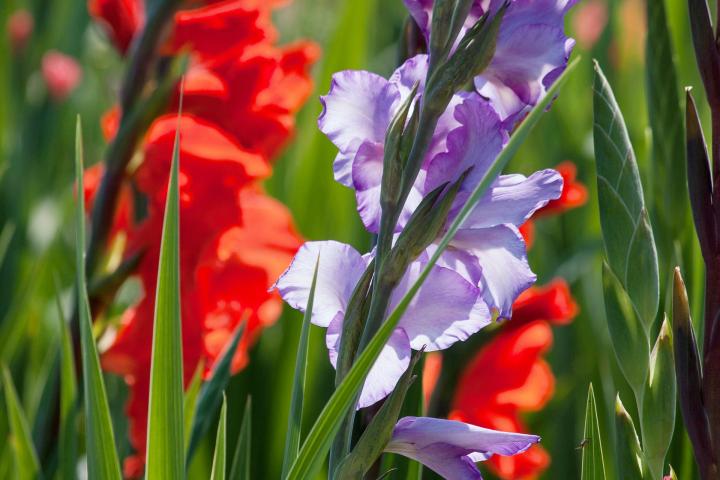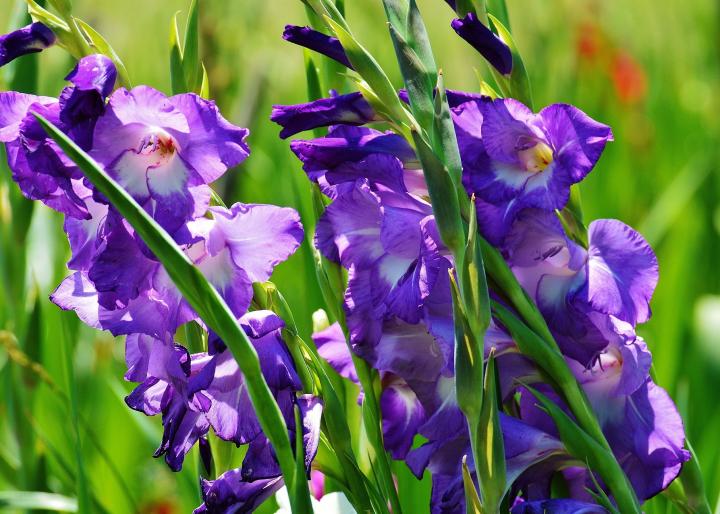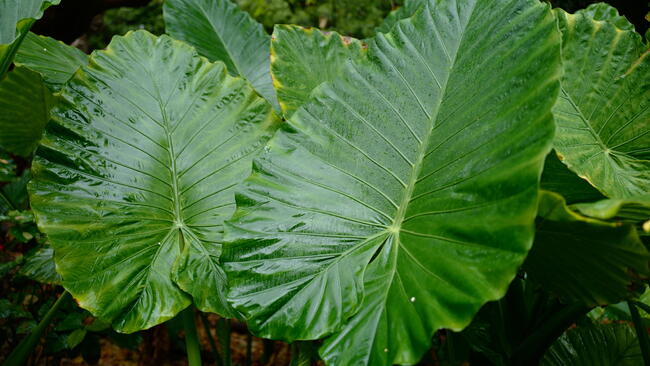
Photo Credit
Tienuskin/Shutterstock
Subhead
Plant gladiolus to enjoy bold blooms and beautiful summer bouquets.
Read Next
Types
Gladioli come in a variety of sizes and colors, with the most popular being part of the following hybrid groups:
- Grandiflora Hybrids: These are the classic gladioli that produce a plentiful amount of large (5- to 6-inch) blooms in a range of colors. The plants produce flower stalks that reach up to 4 feet in height and are winter hardy to Zone 7.
- Dwarf Grandiflora Hybrids: These miniature glads are an excellent choice for containers and cutting gardens, as their flowers are about half the size of Grandifloras, and their shorter stalks don’t typically require staking. They are also winter hardy to Zone 7. Glamini gladioli are included in this group; they are pest-resistant and will bloom in full sun or partial shade.
- Nanus Hybrids: Hardy to Zone 5, these smaller gladioli look a lot like Grandifloras, but do not produce as many flowers. They tend to grow no larger than about 2 feet in height, which makes them perfect for containers or small spaces.
Some specific gladiolus varieties of note include:
- ‘Black Star’ has deep purple-red blooms
- ‘Candyman’ for its beautiful, deep pink flowers
- ‘Costa’ sports ruffled flowers in blue-purple
- ‘Dream’s End’ makes a good background plant because its flower spike is up to 3 feet tall (and it has pretty light orange flowers with large yellow centers)
- ‘Fun Time’ has yellow flowers edged with red
- ‘Green Time’ for its unusual lime-green flowers
- ‘Prins Claus’ has white flowers with splashes of pink on its petals
- ‘Priscilla’ produces off-white flowers with a yellow center and a pink edge
Gardening Products
More Like This
I'm having the same problem! Would love advice - this is my first season with glads in bloom.
Can I plant glads among a rose bed? Are they compatible?
I planted several with pink knockout roses and here in Texas they are starting to bloom! Both the Glads and the roses are healthy and blooming.
I planted glad bulb last year. Due to my health, I did not take up the bulbs. This spring I have all the bulbs growing again, and they have multiple shoots (up to seven per bulb) coming up. I don't know what to do with all the shoots. Leave them, thin them or...
My neighbor has what appears to be glads coming up in her flower bed, she hasn't ever planted any but I have. Is there anyway they could have migrated to her bed? We're baffled.
Thanks
Cheryl
The bulbs may have been moved from your garden to hers by squirrels or chipmunks. I have watched the critters relocate bulbs at my house.
Hmmm..Glads grow from planted corms (bulb-like structures) that are intentionally planted. Most glads do not come back north of zone 8 because they are not winter-hardy.
Update: Clearly, we are hearing other readers mention that their glads are coming back in zones 7, 6 and even 5.
The reason? Perhaps this change is due to shorter, warmer winters. The ground just isn't freezing as deeply. Other factors might be: heavy mulching in wintertime, deeper planting, and good snow cover. The only way to find out? Leave some glads in the ground and see what happens in your area!
I live in z5 in michigan and planted glads 5 years ago. I've never dug them up for the winter and they have become prolific bloomers. I tried digging them up to relocate to my sunnier garden so some of the really small corms have come up. There are now almost 20 plants that should start blooming last year. More light has encouraged taller plants and more blooms.
We live in Zone 7 and my neighbor has Glads growing in her front yard, she is not a gardener, never tends to them, no weeding or fertilizer and they come back every year.
I remember an aunt who had rows of beautiful glads every summer. Every fall she dug them up and every spring she replanted. But I remember her soaking them before she replanted, and I seem to remember my mother saying lye water. I have some stored glad corms, do I need to soak them before re planting?
- « Previous
- 1
- 2
- …
- 10
- Next »












Comments